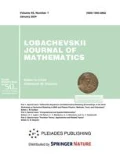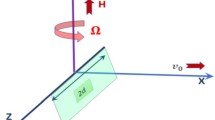Abstract
We consider generalized variational models of media with fields of defects and assume that the tensor of free distortions is interpreted as a dilatation associated with changing of temperature. A variational model of coupled thermoelasticity and stationary thermal conductivity is considered. The model is consistent with the thermodynamics and based parameters of the model are identified from the famous thermomechanical parameters. We assume, that gradient properties are determined by scale parameters which are defined by both mechanical and temperature multiscale effects. The analysis of the boundary value problems is given, and the structure of the fundamental solutions are studied. The fundamental solutions are constructed on the based of generalized Papkovich–Neuber representation using the radial multiplies and are written explicitly in analytical form. It is shown that characteristic roots for the coupled model are satisfied to the algebraic equation of the third order and strong depend on the additional parameters of the model, which describe the coupled effects. As a particular, it is shown that pure oscillation modes can be appear for the temperature, that show the possibility of the thermal waveguide and dynamic instability effects due to coupled effects.

Similar content being viewed by others
REFERENCES
S. A. Lurie, P. A. Belov, and D. B. Volkov-Bogorodskii, ‘‘Variational models of coupled gradient thermoelasticity and thermal conductivity,’’ Mater. Phys. Mech. 42, 564–581 (2019).
L. Y. Bahar and R. B. Hetnarski, ‘‘State space approach to thermoelasticity,’’ J. Therm. Stress. 1, 135–145 (1978).
H. H. Sherief and K. Helmy, ‘‘A two dimensional generalized thermoelasticity problem for a half-space,’’ J. Therm. Stress. 22, 897–910 (1999).
H. H. Sherief, ‘‘State space formulation for generalized thermoelasticity with one relaxation time including heat sources,’’ J. Therm. Stress. 16, 163–180 (1993).
P. A. Belov and S. A. Lurie, ‘‘Ideal nonsymmetric 4D-medium as a model of invertible dynamic thermoelasticity,’’ Mech. Solids 47, 580–590 (2012).
S. A. Lurie and P. A. Belov, ‘‘Theory of space time dissipative elasticity and scale effects,’’ Nanoscale Syst.: Math. Model. Theory 2, 166–178 (2013).
S. A. Lurie and P. A. Belov, ‘‘On the nature of the relaxation time, the Maxwell-Cattaneo and Fourier law in the thermodynamics of a continuous medium, and the scale effects in thermal conductivity,’’ Continuum Mech. Thermodyn., 1–20 (2018).
E. V. Lomakin, S. A. Lurie, P. A. Belov, and L. N. Rabinskiy, ‘‘On the generalized heat conduction laws in the reversible thermodynamics of a continuous medium,’’ Dokl. Phys. 6, 503–507 (2018).
Z. Y. Guo, B. Y. Gao, and M. Wang, ‘‘General heat conduction equations based on the thermomass theory,’’ Front. Heat Mass Transfer 1 013004 (2010).
S. L. Sobolev, ‘‘Transport processes and traveling waves in systems with local nonequilibrium,’’ Sov. Phys. Usp. 34, 217 (1991).
S. L. Sobolev, ‘‘Rapid phase transformation under local non-equilibrium diffusion conditions,’’ Mater. Sci. Technol. 31, 1607–1617 (2015).
S. Forest, J. M. Cardona, and R. Sievert, ‘‘Thermoelasticity of second-grade media,’’ in Continuum Thermomechanics, the Art and Science of Modeling Material Behavior, Ed. by G. A. Maugin, R. Drouot, and F. Sidoroff (Springer, Dordrecht, 2000), pp. 163–176.
E. C. Aifantis, ‘‘Internal Length Gradient (ILG) material mechanics across scales and disciplines,’’ Adv. Appl. Mech. 49, 1–110 (2016).
M. E. Gurtin and A. I. Murdoch, ‘‘A continuum theory of elastic material surfaces,’’ Arch. Ration. Mech. Anal. 49, 291–323 (1975).
S. Lurie, P. Belov, D. Volkov-Bogorodsky, and N. Tuchkova, ‘‘Interphase layer theory and application in the mechanics of composite materials,’’ J. Mater. Sci. 41, 6693–6707 (2006).
P. F. Papkovich, ‘‘Solution générale des équations différentielles fondamentales de l’élasticité, exprimeé par trois fonctiones harmoniques,’’ C. R. Acad. Sci. (Paris) 195, 513–515 (1932).
H. Neuber, ‘‘Ein neuer ansatz zur lösung raümlicher probleme der elastizitätstheorie,’’ Zeitschr. Angew. Math. Mech. 14, 203–212 (1934).
J. M. Doyle, ‘‘A general solution for strain-gradient elasticity theory,’’ J. Math. Anal. Appl. 27, 171–180 (1969).
D. B. Volkov-Bogorodskii and S. A. Lurie, ‘‘Solution of the Eshelby problem in gradient elasticity for multilayer spherical inclusions,’’ Mech. Solids 51, 161–176 (2016).
S. Lurie, D. Volkov-Bogorodskiy, E. Moiseev, and A. Kholomeeva, ‘‘Radial multipliers in solutions of the Helmholtz equations,’’ Integral Transforms Spec. Funct. 30, 254–263 (2019).
S. A. Lurie and D. B. Volkov-Bogorodskiy, ‘‘On the radial multipliers method in the gradient elastic fracture mechanics,’’ Lobachevskii J. Math. 40 (7), 984–991 (2019).
D. B. Volkov-Bogorodskiy and E. I. Moiseev, ‘‘Systems of functions consistent with inhomogeneities of elliptic and spheroidal shapes in problems of continuum mechanics,’’ Lobachevskii J. Math. 40 (7), 1016–1024 (2019). https://doi.org/10.1134/S1995080219070175
H. Bateman and A. Erdelyi, Higher Transcendental Functions (McGraw-Hill, New York, 1953), Vol. 1.
Funding
This work is performed according to the tasks of Ministry of Science and High Education of Russian Federation (IAM RAS) and partially supported by grant no. 18-29-10085 mk of the Russian Foundation of Basic Research.
Author information
Authors and Affiliations
Corresponding authors
Additional information
(Submitted by A. M. Elizarov)
Rights and permissions
About this article
Cite this article
Lurie, S.A., Volkov-Bogorodskiy, D.B., Moiseev, E.I. et al. On Structure of Fundamental Solutions for Coupled Thermoelasticity and Thermal Stationary Conductivity Problems. Lobachevskii J Math 42, 1841–1851 (2021). https://doi.org/10.1134/S1995080221080175
Received:
Revised:
Accepted:
Published:
Issue Date:
DOI: https://doi.org/10.1134/S1995080221080175




